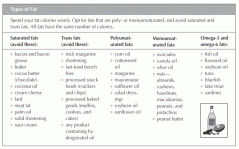Fats and Cholesterol
Everyone needs some fat in their diet to make sure their bodies function properly. Fats are used to rebuild the membranes that protect the cells in your body and to help the cells in your body send signals. Fats are also stored and used as energy reserves.
But too much fat can clog up blood vessels and increase your chances of developing heart disease and stroke. Many Americans eat too much fat. For healthy living, you are better off trying to limit the amount of fat, especially saturated fat and trans fatty acids.
Cholesterol is a kind of lipid substance that your body makes. It is used to make and repair the cell membranes in your body.
Skinny Meat
There are several ways you can reduce the fat in meat:
- Broil, roast, grill, steam, or poach instead of frying.
- Cut off all visible fat before or after cooking and remove the skin from chicken and turkey.
- Chill meat broth and drippings so the fat rises and solidifies. Then it can be skimmed off the top before serving or making gravy. You can also use this method to reduce the fat in canned or homemade broths and soups.
- Buy lean cuts of meat. Ask your butcher to tenderize them through mechanical means rather than with chemical additives.
- Try quick-cooking methods such as stir-frying meat that you have marinated using tiny amounts of olive or canola oil or dressing with lots of seasoning to enhance juiciness and flavor.
It is also used to make many of the steroid hormones such as estrogen and testosterone that your body needs. But too much cholesterol in the blood can clog your arteries and cause heart disease and stroke. In addition to the cholesterol your body makes on its own, the cholesterol and saturated fats that you eat can raise blood cholesterol levels.
Harvey was at risk for a heart attack. He already knew he had
type 2 diabetes. He was about 50 pounds overweight and
was doing his best to watch his carbohydrate intake. But, when
he visited his provider for a checkup last year, he found that his
cholesterol level had skyrocketed.
He decided to cut down on the cholesterol in his diet by
avoiding eggs and not eating red meats. But, his cholesterol levels
were about the same. As his dietitian explained, eating less cho-
lesterol is one step to reducing blood cholesterol but is not benefi-
cial if the saturated fats and trans fatty acids in the diet are not
also reduced. Your body makes cholesterol from the saturated and
trans fats in your diet. She recommended switching to low-fat
dairy products and leaner cuts of meat to reduce Harvey’s intake
of cholesterol and saturated fat. After several months of using
skim milk and low-fat cheeses instead of the high-fat varieties he
was used to, Harvey saw his cholesterol levels start to come down.
How do you know how much fat is in the food you eat?
Sometimes it can be difficult, especially when you are eating out. For foods you buy and prepare yourself, check the food labels. The Nutrition Facts label tells you how much fat, saturated fat, and calories from fat are in one serving. If you are cooking a meal or dish with lots of ingredients, try to add up the fat and calories from each ingredient and divide by the number of servings. If you are eating out, many restaurants, particularly chain and fast food restaurants, now provide nutritional information on request. If you are uncertain about any foods, ask your dietitian for an estimate. At the end of the day, add up all the calories from fat from the labels on the foods you’ve eaten and any other hidden fats in foods without labels. This will give you the total of daily calories from fat. Divide this by the total calories you’ve eaten for the day and multiply by 100.
This will give you the percent of total calories from fat.
Figuring Out Fat
Many people with diabetes have High cholesterol levels. If you need to limit your fat and cholesterol intake, try not to eat more than 300 milligrams of cholesterol a day. If your LDL cholesterol is over 100 mg/dl, you may benefit by reducing your cholesterol intake to less than 200 milligrams per day. Less than 30 percent of your total calories each day should come from fat (with less than 10 percent from saturated fats). If you find that you’ve eaten too much fat or cholesterol in one day, eat less for the next couple of days.
Here’s an easy way to figure out how much fat to eat each day.
First, decide on the number of calories you eat in a day. Let’s say you eat 1,800 calories a day. Drop the last number, so 1,800 becomes 180. Now divide by 3. The answer, which is 60, is the number of grams of fat you can eat each day and still end up eating less than 30 percent of your total calories from fat.
Hidden Fat. Be careful when you find cookies marked as “sugar free” or other desserts marketed specifically for people with diabetes. They may be sugar free, but more than 60 percent of their calories can come from fat. You will find saturated fat in all animal products such as butter, whole milk, half-and-half, and meat fat.
The vegetable products high in saturated fats and trans fatty acids are palm oil, palm kernel oil, cocoa butter (chocolate), coconut oil, solid shortening, and partially hydrogenated oils. Often these fats are found in mixes for pancakes, biscuits, cookies, crackers, cakes, and some snack chips.
